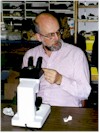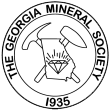Why Micromounting?
by
Julian Gray, P.G.

At the November(1997) GMS meeting, Dave Babulski made the suggestion that a micromount section be created. Some may ask, Why? What's the appeal of micromounts? Among those would be one of my collecting partners, a self-proclaimed member of the "TenPounder Club"; the collector who prefers to collect minerals that can be seen from across the room. When most of us started collecting, we most likely collected just about anything, choosing to specialize later. Some collect crystals, others fossils, and some prefer to collect semiprecious gems that can be polished and set in jewelry. Even those who collect only minerals develop subspecialties such as a single species, state, district, country, mine, crystal type, physical property (fluorescence for instance), or size. Size categories include (in descending size) outcrop, museum, cabinet, miniature, thumbnail, and micro. A recent addition is the toenail. My guess is that only two types of collectors would specialize in toenails; those who have competed and won in every other category at shows, and those who have not yet won a competition. So why do I and a few others in the Society collect specimens whose true beauty can be seen only when magnified 20 times?
The appeal of micromounts can be found in this definition of a micromount. The late Neal Yedlin, the world's biggest micromounter, defined a micromount as "a natural mineral specimen, preferably in distinct crystals, mounted, properly labeled, and requiring magnification for meaningful observation." Most people get hung up on the cost of the "requiring magnification" part. At less than a few hundred dollars, serviceable new and used microscopes are actually not out of reach for beginners. My Ten-Pounder Club friend bought a used scope at the Lakewood flea market for $40! So, what else?
Micromineral specimens are frequently well crystallized. As crystals grow larger, the faces of the crystal may contact other crystals or the walls of the cavity in which it is growing. Also minor modifications of crystal forms give way to dominant forms. The chances of damaging a larger crystal when collecting is also greater. Microminerals are, therefore, generally better crystallized, better preserved, and more fascinating than larger crystals of the same species. And for those of you who are attempting to collect as many different species as possible? First of all, the 1995 Glossary of Mineral Species lists 3,521 species, and about 44 new species are discovered per year. Good luck! Furthermore, most of these occur only as micros. If you insist on becoming a species collector, your chances are better with micromounts. And as for oddities of the mineral kingdom (one mineral impaled on another, inclusions, scepters, rings, twins, etc.), micromounts are unequaled.
Perhaps the most rewarding part of this aspect of our hobby is the micro-mounting. Microminerals are trimmed to fit an appropriate sized box for safe, convenient storage. I would like to emphasize here that you do not have to fit a specimen in a tiny box to create a micromount. If you cannot trim a specimen to fit a micro box without ruining the specimen, find a bigger box. I enjoy seeing all the ways people have found to display micros: rotating specimen holders, reflectors under transparent samples, indexed mounts to facilitate finding unique crystals. Micromounting is like framing a natural work of art, each mount requires a setting as unique as the mineral itself. Each micromounter typically develops a style of his/her own.
As I write this(December, 1997) Dave Babulski is preparing a workshop for micromounting for our December show. I hope that all of you will have had the opportunity to view his display and will support his efforts in the coming year. I can't speak for all of the micromounters in the Society, but Dave, Charlie Hall, and I will make every effort to encourage those interested in pursuing this aspect of the mineral hobby.

Copyright © Georgia Mineral Society, Inc.
